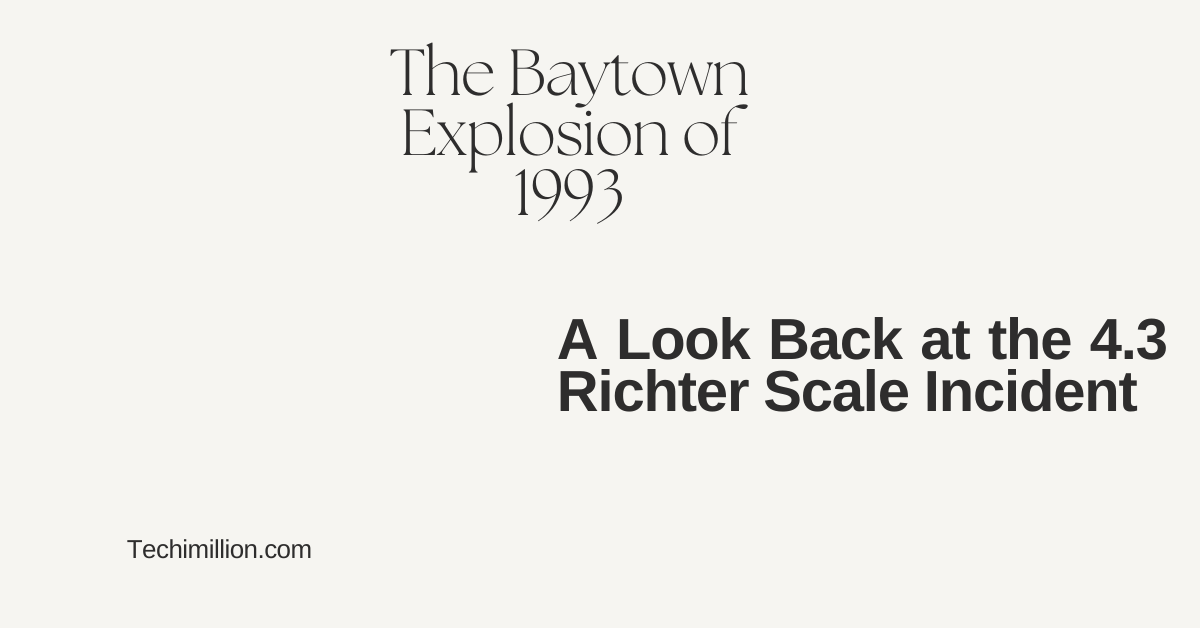Baytown Explosion 1993 4.3 Richter Scale
The city of Baytown, Texas, has long been an industrial hub, home to various petrochemical plants and refineries. In 1993, Baytown experienced a significant industrial accident—an explosion that registered 4.3 on the Richter scale. This event left an indelible mark on the community, raising concerns about industrial safety and the impact of such accidents on nearby residents. In this blog, we revisit the Baytown explosion of 1993, examining its causes, impact, and lessons learned from the incident. This SEO-optimized article provides comprehensive information for those seeking to understand the event and its significance.
What Happened in Baytown in 1993?
Overview of the Explosion
On March 27, 1993, a powerful explosion occurred at a petrochemical facility in Baytown, Texas. The explosion was so significant that it registered 4.3 on the Richter scale, a measurement typically associated with seismic activity. The blast was felt by residents miles away, many of whom initially thought it was an earthquake due to the strength of the vibrations and the rumble that followed.
The explosion took place at the ExxonMobil Baytown Complex, one of the largest petroleum and petrochemical facilities in the United States. The site was known for its production of oil, gasoline, and chemicals and was a critical part of Baytown’s industrial landscape.
Causes of the Explosion
The explosion was linked to a combination of equipment failure and operational issues. Investigations revealed that the incident originated from a malfunction in the plant’s process system, which led to the release of flammable gases. Once these gases encountered an ignition source, it triggered a massive blast that shook the surrounding area.
The incident highlighted the importance of stringent safety protocols, regular maintenance, and adherence to operational procedures in high-risk industrial environments. It also prompted discussions about safety regulations and risk management practices in the petrochemical industry.
The Impact of the 1993 Baytown Explosion
Local Community and Residents
The Baytown explosion had a profound impact on the local community. Many residents reported feeling the ground shake, and windows were shattered in homes and businesses within a significant radius of the blast. While there were injuries reported, fortunately, no fatalities occurred. However, the event caused considerable fear and concern among residents, particularly those living near the industrial facility.
The explosion served as a stark reminder of the risks associated with living near petrochemical facilities. Many residents voiced concerns about the safety measures in place and whether enough was being done to protect the community from similar incidents in the future.
Environmental Impact
The explosion also had environmental consequences. The release of chemicals and the resulting fire raised concerns about air quality and potential contamination. Environmental agencies were involved in monitoring air quality and assessing any long-term damage caused by the incident. The explosion drew attention to the need for better environmental safeguards and emergency response measures to address potential chemical releases.
Lessons Learned from the Baytown Explosion

Importance of Safety Protocols
One of the key lessons from the Baytown explosion was the critical importance of safety protocols and preventive maintenance in industrial operations. The incident underscored the need for petrochemical facilities to invest in safety measures, such as regular equipment inspections, hazard assessments, and employee training. Proper safety protocols could potentially prevent equipment malfunctions that lead to catastrophic events like the Baytown explosion.
Regulatory Changes
In the aftermath of the explosion, there was increased focus on industrial safety regulations. The incident prompted both state and federal regulatory bodies to re-evaluate existing safety standards for petrochemical facilities. This led to the implementation of more stringent regulations, aimed at preventing similar incidents.
The Occupational Safety and Health Administration (OSHA) and the Environmental Protection Agency (EPA) worked with the industry to establish better safety practices, conduct inspections, and enforce compliance with safety standards.
Community Preparedness and Awareness
The explosion also emphasized the importance of community preparedness and awareness. The event highlighted the need for effective emergency response plans, not only for industrial facilities but also for the surrounding community. Public awareness campaigns were launched to educate residents on how to respond in case of an industrial accident, and community drills were organized to improve readiness.
How Baytown Has Changed Since the 1993 Explosion
Improved Safety Measures
Since the explosion, the ExxonMobil Baytown Complex and other facilities in the area have made significant strides in improving safety measures. Investments have been made in modern equipment, automated monitoring systems, and comprehensive employee training programs to ensure safety is a top priority. These measures aim to minimize the risk of similar incidents in the future.
Stronger Community Relations
Efforts have also been made to improve communication and trust between petrochemical facilities and the local community. Community advisory panels were established to foster open dialogue between plant operators and residents, allowing for greater transparency and better understanding of risks and safety measures.
These advisory panels have helped build stronger relationships and ensure that residents are informed about facility operations, safety protocols, and potential risks. The collaboration between the community and facility operators has been a key factor in creating a safer environment for everyone.
Conclusion: Remembering the Baytown Explosion of 1993

The Baytown explosion of 1993 was a significant event that had a lasting impact on the community, the environment, and the petrochemical industry. Registering 4.3 on the Richter scale, the explosion served as a wake-up call for improved safety protocols, better regulatory oversight, and increased community preparedness.
While the incident caused fear and disruption, it also led to important changes that have helped prevent similar accidents in the future. The lessons learned from the Baytown explosion continue to shape safety standards and practices in the petrochemical industry today.
By understanding the causes and impact of the 1993 Baytown explosion, we can appreciate the importance of safety, preparedness, and proactive measures in ensuring the well-being of both workers and the surrounding community. If you live near an industrial facility, staying informed and involved in community safety initiatives is essential for creating a secure environment for everyone.

